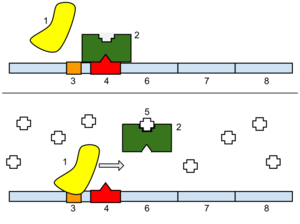Promoter (genetics) facts for kids
In genetics, a promoter is a special part of DNA. It acts like a "start" signal for a gene. When this signal is read, it tells the cell to begin making a protein or other important molecule from that gene. This process is called transcription.
Promoters are always found very close to the genes they control. They are on the same DNA strand and are located "upstream," meaning before the gene itself.
These important DNA sections can be quite long, usually between 100 and 1,000 base pairs in length. Think of base pairs as the building blocks of DNA.
What Promoters Do
For a gene to be used, a special enzyme called RNA polymerase needs to attach to the DNA right near the gene. This enzyme is like a tiny machine that reads the DNA and makes a copy of it, which is called RNA.
Promoters have specific DNA codes that tell the RNA polymerase exactly where to attach. Other proteins also help the RNA polymerase to bind, or sometimes even stop it from binding. This whole system of turning genes on and off, or adjusting how much they work, is called "the regulation of gene expression."
- In bacteria
- The promoter is recognized by the RNA polymerase and another protein that helps it. It's a simpler system.
- In eukaryotes (like plants and animals)
- The process is more complex. Many different helper proteins, sometimes called "factors," are needed for the RNA polymerase to attach to the promoter and start reading the gene.
Promoters are key parts of our DNA. They work together with other control areas to make sure genes are turned on when they are needed and turned off when they are not. They also help adjust how much of a gene's product is made, depending on what the cell needs.
Images for kids
See also
 In Spanish: Promotor (genética) para niños
In Spanish: Promotor (genética) para niños





